
The Auriculariales are an order of fungi in the class Agaricomycetes. Species within the order were formerly referred to the "heterobasidiomycetes" or "jelly fungi", since many have gelatinous basidiocarps that produce spores on septate basidia. Around 200 species are known worldwide, placed in six or more families, though the status of these families is currently uncertain. All species in the Auriculariales are believed to be saprotrophic, most growing on dead wood. Fruit bodies of several Auricularia species are cultivated for food on a commercial scale, especially in China.

The Auriculariaceae are a family of fungi in the order Auriculariales. Species within the family were formerly referred to the "heterobasidiomycetes" or "jelly fungi", since many have gelatinous basidiocarps that produce spores on septate basidia. Around 100 species are known worldwide. All are believed to be saprotrophic, most growing on dead wood. Fruit bodies of several Auricularia species are cultivated for food on a commercial scale, especially in China.

The Hyaloriaceae are a family of fungi in the order Auriculariales. Species within the family have gelatinous basidiocarps that produce spores on septate basidia and, as such, were formerly referred to the "heterobasidiomycetes" or "jelly fungi". All appear to be saprotrophic, growing on dead wood or plant remains. Less than 30 species are currently included within the Hyaloriaceae, but the family has not been extensively researched.

Exidia is a genus of fungi in the family Auriculariaceae. The species are saprotrophic, occurring in attached or recently fallen dead wood, and produce gelatinous basidiocarps. The fruit bodies are diverse, pustular, lobed, button-shaped or cup-shaped. Several species, including the type species Exidia glandulosa, have sterile pegs or pimples on their spore-bearing surface. The genus has a cosmopolitan distribution and around 20 species are currently recognized worldwide. Initial molecular research indicates the genus is artificial.

Exidia glandulosa, commonly known as black witches' butter, black jelly roll, or warty jelly fungus, is a jelly fungus in the family Auriculariaceae. It is a common, wood-rotting species in Europe, typically growing on dead attached branches of oak. The fruit bodies are up to 3 cm (1.2 in) wide, shiny, black and blister-like, and grow singly or in clusters. Its occurrence elsewhere is uncertain because of confusion with the related species, Exidia nigricans.

Exidia nigricans is a jelly fungus in the family Auriculariaceae. It is a common, wood-rotting species throughout the Northern Hemisphere, typically growing on dead attached branches of broadleaf trees. It has been much confused with Exidia glandulosa.

Exidia recisa is a species of fungus in the family Auriculariaceae. In the UK, it has the recommended English name of amber jelly. Basidiocarps are gelatinous, orange-brown, and turbinate (top-shaped). It typically grows on dead attached twigs and branches of willow and is found in Europe and possibly elsewhere, though it has long been confused with the North American Exidia crenata.
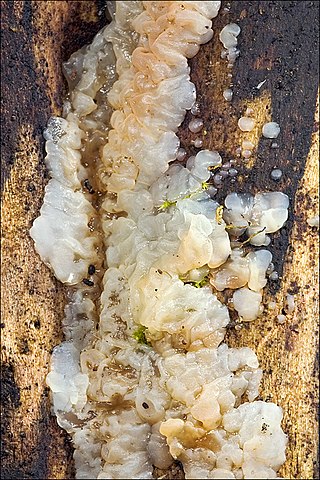
Exidia thuretiana is a jelly fungus in the family Auriculariaceae. The fruit bodies are white and gelatinous with brain-like folds. It is a common, wood-rotting species in Europe, typically growing on dead attached or fallen branches of broadleaf trees, especially beech.
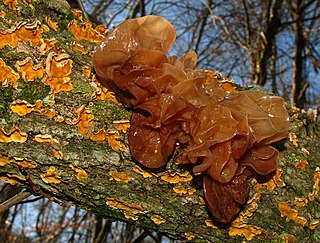
Phaeotremella frondosa is a species of fungus in the family Phaeotremellaceae producing brownish, frondose, gelatinous basidiocarps. It is widespread in north temperate regions, and is parasitic on other species of fungi that grow on dead attached and recently fallen branches of broadleaf trees.

Naematelia aurantia is a species of fungus producing yellow, frondose, gelatinous basidiocarps. It is widespread in north temperate regions and is parasitic on another species of fungus that grows on dead attached and recently fallen branches of broadleaf trees. It is commonly called golden ear in North America.
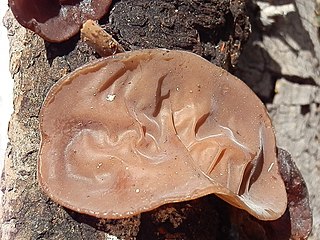
Auricularia americana is a species of fungus in the family Auriculariaceae found in North America and East Asia. Its basidiocarps (fruitbodies) are gelatinous, ear-like, and grow on dead conifer wood.
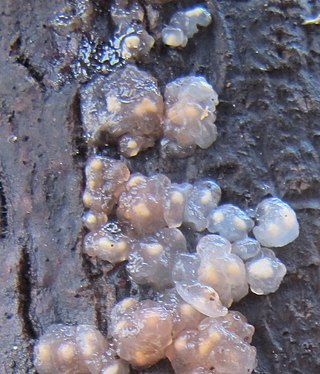
Myxarium is a genus of fungi in the family Hyaloriaceae. Basidiocarps are gelatinous and effused or pustular. The genus is cosmopolitan. All species grow on dead wood or dead herbaceous stems.

Cystobasidium fimetarium is a species of fungus in the order Cystobasidiales. It is a fungal parasite forming small gelatinous basidiocarps on various ascomycetous fungi on dung. Microscopically, it has auricularioid basidia producing basidiospores that germinate by budding off yeast cells. The species is known from Europe and North America.

Phaeotremella mycophaga is a species of fungus in the family Phaeotremellaceae. It produces small, pustular, gelatinous basidiocarps on the hymenium of the corticioid fungi Aleurodiscus amorphus and A. grantii on conifers.
Tremella versicolor is a species of fungus in the family Tremellaceae. It produces small, pustular, gelatinous basidiocarps and is parasitic on the basidiocarps of Peniophora species, a genus of corticioid fungi, on dead attached or recently fallen branches. It was originally described from England.
Tremella exigua is a species of fungus in the family Tremellaceae. It produces small, dark, pustular, gelatinous basidiocarps and is parasitic on pyrenomycetous fungi on dead branches of trees and shrubs. It was originally described from France.
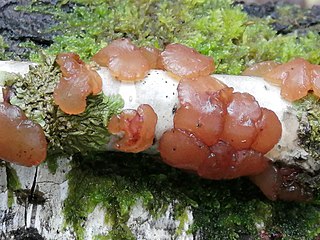
Exidia repanda is a species of fungus in the family Auriculariaceae. In the UK, it has the recommended English name of birch jelly. Basidiocarps are gelatinous, orange-brown, and button-shaped. It typically grows on dead attached twigs and branches of birch and has been recorded from Europe, North America, and Japan.
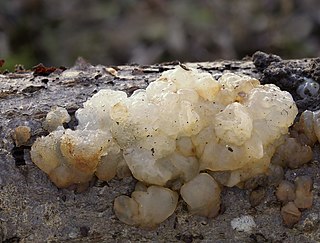
Exidia candida is a species of fungus in the family Auriculariaceae. Basidiocarps are gelatinous, whitish, and cushioned-shaped at first, becoming effused and corrugated.
Exidia purpureocinerea is a species of fungus in the family Auriculariaceae. Basidiocarps are gelatinous, densely covered in small spines, purple-grey, and cushioned-shaped at first, becoming effused. The species occurs in southern Africa on dead wood.
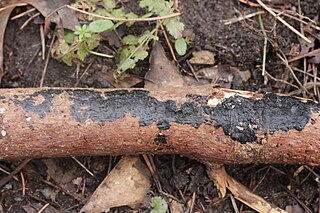
Exidia pithya is a species of fungus in the family Auriculariaceae. Basidiocarps are gelatinous, black, and button-shaped at first, later coalescing and drying to form tar-like patches. The species grows on dead branches of conifers in continental Europe.


















